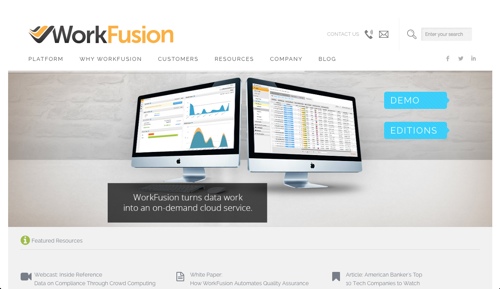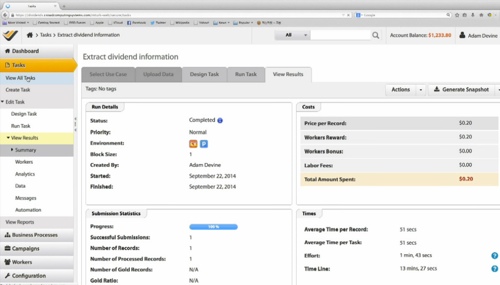 When the going gets good for online investment advisory innovators, the good online investment advisory innovators go pro.
When the going gets good for online investment advisory innovators, the good online investment advisory innovators go pro.
Alumni News– November 19, 2014
 eFLOW Crowdbridge from Top Image Systems voted one of the three best ECM Solutions for 2014.
eFLOW Crowdbridge from Top Image Systems voted one of the three best ECM Solutions for 2014.
- Technocular interviews WePay founder and CEO, Bill Clerico.
- Allied Payment Network launches its new small business payments solution, BizPay.
- Kapitall and Motif Investing both referenced in Investment News column on data visualization.
- Kahuna Payment Solutions chooses e-SignLive by Silanis, bringing e-signatures into its lending platform for retailers.
- Syd Youth partners with CSI globalVcard to promote Spend Secure.
- Banking 20/20 interviews EyeVerify EVP of Global Sales & Marketing, Chris Barnett.
- Silicon Republic features Fenergo software developer, Marcio Duarte.
- Business Insider reviews FutureAdvisor.
- Credit Sesame wins IMA Outstanding Achievement Award in Financial Services.
- FinovateEurope 2015 Presenting Companies Revealed. Get Your Ticket this Week for Very Early Bird Pricing!.
Finovate Debuts: WorkFusion
The Finovate Debuts series introduces new Finovate alums. At FinovateFall 2014, WorkFusion launched its active learning automation solution.
- Founded in June 2010
- Headquartered in New York, NY
- Raised $23 million in total funding
- Builds and refreshes data products for seven out of the top 10 financial data providers
- Has 68 employees
- Max Yankelevich is CEO and Co-Founder
- Launched WorkFusion’s Active-Learning Automation in September 2014
n concurs. Going forward, the company plans to expand the size of its business process template library to make it even easier for businesses to find the processes they need without having to create them. The goal is to allow large businesses to elevate the application of human intelligence to higher order work, and automate the work that human’s shouldn’t be doing. And to deliver all this via one-click custom automation.
Six Digital Myths Hampering Banks’ 2015 Strategic Planning

In late summer, I published a two-part post detailing the most important retail banking projects for next year (here and here). I’ve got another installment or two in the pipeline, but since it’s already starting to feel like we are making our final descent into 2015, I wanted to take a step back and explain WHY those projects rose to the top.
Truth: Branch banking is on the way out.
- I get that people like the local branch. My wife loved Blockbuster. My grandparents operated a much-loved corner grocery. But neither survived when the economics turned against them. Bank branches will survive in my lifetime, but their footprint (square feet & staffing) will decline 5% to 10% per year for the foreseeable future.
- Name one thing done in a branch that can’t be done more efficiently and/or more effectively through digital means or an ATM (let’s assume that the customer believes resolution can be obtained from either method). Sure, people still go to the branch for advice and problem solving since that’s a long-standing tradition and it’s comforting to talk to a nice person in a pressed blue shirt. But it’s also an inefficient way to get things done, for both the bank and the customer. My last trip to the branch was to open a college checking account at the bank we’ve held accounts for seven years (and whose associates know us by sight). It took an hour! And that doesn’t include the travel time for two trips to the branch (we forgot to bring a SECOND picture ID). It all could have been done in a few minutes online or via mobile had that option been available.
Myth 2 >> Desktop online banking is still needed for “serious” work
- Many people still think that “important work” requires a browser and the real estate of a 13-inch screen. I agree for writing or design tasks, that’s true. But the average banking interaction amounts to looking at a few two- and three-digit numbers and typing a search term every now and then. Those things can be easily done on mobile.
- In fact, by building the UI mobile first, designers are forced to focus on the most important data elements, creating a better experience.
———
Truth: Consumer and SMB lending could be disrupted by new players (but that’s far from a given).
Prediction: Marketplaces take 5% to 10% share by 2020
- I’m not one to throw “disruption” around lightly. In fact, it has never appeared in a title in my 10 years of blogging. Why not? Because I’ve been working in the online banking industry for 22 years and have seen nearly ZERO market share shift in the U.S. banking system over that time. The only major U.S. Internet-only success was ING Direct (now Capital One). And they don’t count because it was a division of a huge legacy player expanding their geographic reach. (Note: There has been market share shifts in the acquiring side due to PayPal, Square and others, but that was mostly wrested away from non-banks.)
- But marketplace lending (aka P2P) is the first thing I’ve seen that actually is taking share away from legacy players. Lending Club is over $2 billion; Prosper and Zoka are over $1 billion; and SOFI is probably there as well. And there are more than 100 equity and debt crowdfunding companies funding small and medium businesses. While this is still small change in the multi-trillion consumer and SMB lending market, there are signs that these companies are posed to grab meaningful share.
- What makes the lending marketplace model potentially disruptive is that they can bring together large pools of capital with very different risk tolerances and price the loans dynamically, which is much harder for traditional players to do (though regulation is a wildcard here as marketplaces could end up with draconian “safeguards” that would render their risk-based pricing advantage moot)
- But I don’t count out the big players yet. While it’s not easy, they can and probably will, copy the marketplace lending model, and perhaps continue their role as primary credit providers. However, having been a lending-product manager at a major bank, I can attest that it is extremely difficult to change historic patterns in loan underwriting.
- Ever since I’ve been involved, it’s been debated whether banks could be “the one-stop shop” for financial services. In the pre-Internet era, it was prohibitively expensive to put world-class mortgage bankers, investment advisors, insurance experts, remittance providers, SMB services, and so forth into the branch-based delivery model.
- But in today’s interconnected “API” world, that is not the case. The financial provider with the most trust — or as Richard Crone says, “The company that enrolls, controls” — can deliver the best of everything related to money management, retirement planning, value investing, and risk management/insurance. Consumers actually do gravitate towards one source if they believe it’s delivering value across disparate items. Case in point: Amazon.com. (Note: I penned my favorite report of all time around that theme, Building the Amazon.com of Financial Services (original in 1998, updated in 2000.)
- I’m not sure how banks have gotten away with such lax consumer/SMB-facing security for so long. It’s a testament to the strength of their core businesses that they can cover billions in losses every year.
- It’s also an unintended consequence of offering all digital banking services free of charge. Every tweak to the website and mobile app are new costs without any tangible revenue bump (see Myth 6 below).
- But we are finally reaching the end of the username/password era with better authentication via smartphone, far more sophisticated back-end fraud-monitoring, and seamless biometrics (aka TouchID). I, for one, will be able to sleep better, knowing our business isn’t constantly on the brink of a devastating cybertheft.
——–
Alumni News– November 18, 2014
 Coinbase to introduce bitcoin tip button to enable micropayment acceptance online.
Coinbase to introduce bitcoin tip button to enable micropayment acceptance online.
- Venmo users can now log in using both bank ID and Touch ID.
- OnDeck seeks to raise $150 million in initial public offering.
- TechWeek Europe takes a look at Arxan Technologies’ State of Mobile App Security report.
- Malaysian Digest features Azimo in a discussion on the revolution in the money transfer industry.
- Dough Roller interviews iQuantifi CEO and Co-Founder, Tom White.
- Business News Daily quotes Igor Gonta, CEO of Market Prophit on the importance of having a social media strategy.
- PostFinance AG’s Monexio selects Mobino platform to help develop its own digital payment solutions.
- SK Planet wins first prize at KPRA Awards 2014 for its filter program, Flitter.
- Credit Sesame partners with Prosper.
- Hiscox launches new digital insurance platform powered by Backbase CXP.
- PayPal challenges Apple Pay with an app for the Pebble smartwatch.
- The European Commission approves Tradeshift data format for government purchasing.
OnDeck Seeks to Raise $150 Million in Initial Public Offering
![]()
Alternative small business lender OnDeck has announced plans to raise $150 million in an initial public offering.
According to analysis from The Wall Street Journal, the IPO could value OnDeck at $1.5 billion. The Journal also suggested that the $150 million number for the IPO was likely a “placeholder amount” that will probably change.
“I think just like today I buy a plane ticket online with Priceline.com. Maybe 20 years ago I would have talked to a travel agent. You know – we are going through that entire cycle. We’re probably in year five of a 20-year journey in terms of lending.”
- OnDeck will trade on the New York Stock Exchange (NYSE) under the ticker symbol, ONDK
- Lead underwriter is JP Morgan Stanley
- Originated more than $1.7 billion in loans to 25,000 small businesses
- Raised more than $170 million in venture capital funding, and more than $300 million in debt financing
- Collected more than 4 million customer payments
- Previous investors include:
- RRE Ventures
- Institutional Venture Partners
- Village Ventures
- SAP Ventures
- First Round Capital
- Google Ventures
- Tiger Global
Alumni News– November 17, 2014
 Boku announces a pair of C-level appointments: Ingo Lippert as CBO, Christian Hinrichs as CFO.
Boku announces a pair of C-level appointments: Ingo Lippert as CBO, Christian Hinrichs as CFO.
- Zopa partners with AltFi Data; plans to open loan book to the public in Q1 in 2015.
- The Sunday Times profiles TransferWise founders Kristo Kaarmann and Taavet Hinrikus.
- TradeKing begins rollout of its new 100% responsive website.
- Bolstr surpasses $200,000 in 2014 investor payouts
- Expensify featured in Slate. Check out the video.
- Billhighway’s 523% Four-Year Growth earns it the #193 Spot on the Deloitte Technology Fast 500 List.
- ChicagoInno features Arroweye Solutions and Rippleshot for their listings on the FinTech Forward Rankings.
- Check out Finovate Debuts: Minetta Brook’s Knewsapp.
- MetaIntelli and Arxan Technologies partner to help developers mitigate mobile security and privacy risks.
- Venmo gets Touch ID security, tagging, and direct linking to bank accounts.
- MyBankTracker examines how 1U is using Hoyos‘ facial recognition security technology.
- InComm launches New eCommerce Site for B2B Bulk Gift Cards.
- Bluefin joins the New York Bankers Association.
- Google Compute Engine now features intelligent horizontal Autoscaling.
- Wharton Fintech blog features Knox Payments.
Finovate Debuts: Minetta Brook’s Knewsapp
The Finovate Debuts series introduces new Finovate alums. Today’s feature is Minetta Brook, which demonstrated Knewsapp at FinovateFall 2014.
Minetta Brook aims for Knewsapp to change the way investors stay informed of news relating to stocks in their portfolio. The web-based news discovery application surfaces topics before they become trending news, giving researchers a tool superior to Google.
The stats
- $2.4 million in funding
- 10 employees
- 100+ firms in beta
- 100,000+ news sources searched
Traditionally, when seeking information that may effect a stock in their portfolio, investors search Google, Yahoo or other investment info sources. But typical search engines measure the importance of an article based on popularity.This method elevates content that could be days old, and buries stories investors actually need to read.
For traders, risk management professionals, and research analysts that need real-time news, search engines are not the best tools for content discovery. Knewsapp’s content-based model finds the information investors need to make important trading decisions.
Aside from simply serving up news, Knewsapp also helps investors know what news may effect their investments. It uses a proprietary scoring method to suggest content they should read to be informed, based on their portfolio.
Knewsapp launched on Bloomberg in May. Here’s what the full integration looks like:
Knewsapp continuously scans Twitter and more than 100,000 sources of news and blogs for unusual activity. The result is a list of stocks with the most relevant and fastest developing news, based on their score and velocity.
Ticker and/or topic combination search
With this function, users search a ticker symbol by itself or in combination with key word(s). The result shows headlines of relevant news stories, sources, scores and similar topics.
Additionally, a filter capability enables users to see news in specific markets or sectors.
Portfolio monitoring
With hundreds of stocks in a portfolio, it can be difficult to know which terms to search. Knewsapp simplifies this by displaying the score, along with the rate the news is developing, for each stock in a portfolio.
When users filter by the score or velocity, they see which stocks are receiving above average coverage in the news or on Twitter. The right-hand panel displays news stories corresponding to stocks in their portfolio.
Story DNA
The Story DNA section word cloud displays a quick view of topics and themes within a selected news story.
Minetta Brook debuted the public web version of Knewsapp at FinovateFall 2014.
Financeit Brings in Fresh Funding After U.S. Launch
What do wonders of the world, deadly sins, the Harry Potter series, and Financeit’s funding have in common? They all come in sets of seven (at least for now).
Financeit’s seventh round of funding comes from BEST Funds, which is adding an undisclosed amount to the $21.4 million Financeit has raised since its 2007 launch.
Previous rounds include $13 million in November 2013, along with $8.4 million in angel funding received in five rounds from 2007 to 2012.
The new installment comes a few months after the Toronto-based company launched its point of sale financing solution in the United States. This is no small feat, given the hurdles of complying with U.S. regulations. Financeit plans to use the funds to expand growth in the new market.
Another +1 For Host Card Emulation: SimplyTapp Garners $6 Million
Host Card Emulation (HCE) solutions company, SimplyTapp, is making it easier for banks to place their own tap to pay functionality in customers’ hands.
To further this mission, two investors, Blue Sky Capital and Lightspeed Venture Partners, recently contributed $6 million in Series B funding to the Austin-based startup.

Other funding rounds include a $1.4 million Series A round last November and a $200,000 seed round in February of 2013. Its total funding now tallies just over $7.5 million.
Check out SimplyTapp’s video from FinDEVr San Francisco 2014, where it explains HCE.
Alumni News– November 14, 2014
 IntelliResponse acquired by [24]7 for its customer service suite.
IntelliResponse acquired by [24]7 for its customer service suite.
- Another +1 For Host Card Emulation: SimplyTapp Garners $6 Million.
- Financeit Brings in Fresh Funding After U.S. Launch.
- Payfone selected as “Best Revenue Creator/Enhancer” for Mobile Network Operators in the 2014 Fierce Innovation: Telecom Edition Awards.
- InComm & PayPal collaborate to offer digital gift cards.
Fintech Fundings: More than $145 Million Raised Week Ending Nov 14
- Austin, TX-based SimplyTapp attracted $6 million to expand its NFC mobile payment technology.
- FinanceIT secured an undisclosed investment from Toronto neighbor BEST Funds.













